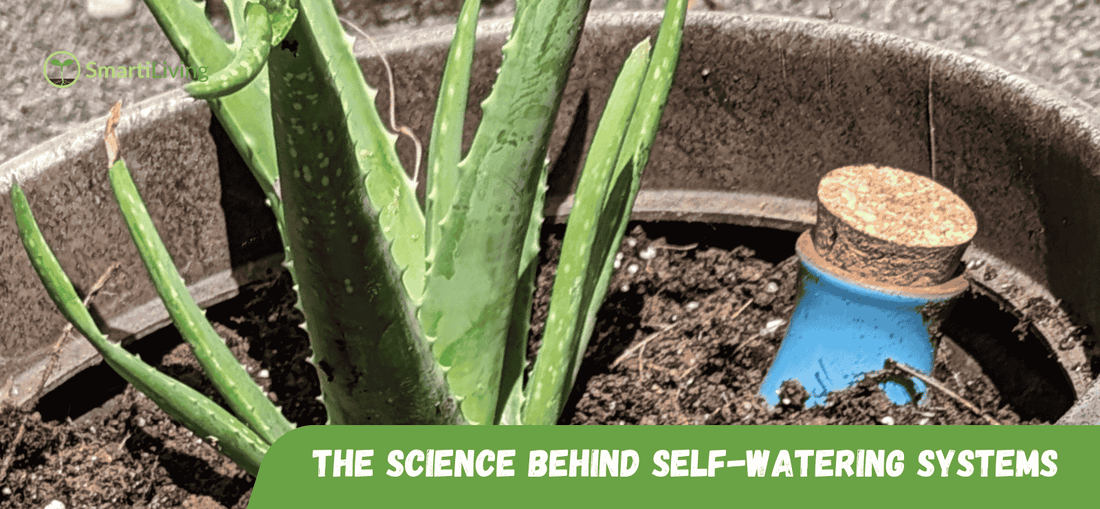
The Science Behind Self Watering Systems: How Smart Technology Beats Hand Watering
Share
For generations, plant care has been a guessing game of when and how much to water. But what if you could leverage natural physics to automate perfect plant hydration? Modern self watering system technology does exactly that, transforming how we care for plants by working with nature rather than against it.
This isn't just about convenience it's about understanding the botany and physics that make a self watering system more effective than even the most attentive gardener with a watering can. Let's explore the fascinating science that makes these systems so remarkably efficient.
The Core Physics Principles Behind Every Self Watering System
At their heart, all self watering system designs operate on one or more fundamental principles of physics: capillary action, soil moisture tension, and gravity. Understanding these reveals why these systems are so effective.
1. Capillary Action: Nature's Water Pump
Capillary action is the ability of a liquid to flow in narrow spaces without the assistance of, or even in opposition to, external forces like gravity. This is the same principle that allows water to travel up a paper towel from one end to the other.
In a self watering system: This is the key mechanism in wicking beds and some spike designs. Water moves upward from a reservoir through a wick (like a rope or porous soil) and into the root zone, defying gravity to deliver moisture exactly where it's needed.
2. Soil Moisture Tension: The Plant's Natural Thirst Gauge
Soil moisture tension refers to the force with which water is held in the soil. Dry soil has high tension, powerfully pulling and holding onto water. Wet soil has low tension.
In a self watering system: This is the genius behind terracotta spikes and ollas. The porous terracotta acts as a membrane. When the surrounding soil is dry (high tension), it pulls water through the clay's microscopic pores. When the soil is moist (low tension), the pull stops. This creates a perfectly self-regulating self watering system that responds directly to the plant's environment.
3. Gravity and Vacuum: The Regulated Flow
Gravity is the force that pulls water downward, while a vacuum is a space devoid of matter.
In a self watering system: Glass watering globes use these principles. Gravity wants to pull the water out, but a partial vacuum formed inside the globe prevents it. As the soil dries, air enters the stem, breaking the vacuum and allowing gravity to pull a small amount of water out. The cycle repeats, creating a slow, regulated drip.
A Detailed Comparison: How Different Self Watering System Types Operate
Not all systems are created equal. Here’s how the most common types leverage these scientific principles.
| System Type | Primary Scientific Principle | How It Works | Best For |
|---|---|---|---|
| Terracotta Spikes & Ollas | Soil Moisture Tension | Porous clay releases water only when soil is dry. Perfectly self-regulating. | Garden beds, large pots, water-sensitive plants |
| Glass/Plastic Globes | Gravity & Vacuum Pressure | Air replaces water in the bulb as soil dries, creating a slow, gravity-fed drip. | Houseplants, short-term vacation care |
| Wick-Fed Planters | Capillary Action | A fabric wick draws water from a reservoir up into the soil. | Consistent moisture lovers like herbs and seedlings |
| Electronic Sensor Systems | Digital Moisture Sensing | A probe measures soil moisture and a pump activates only when needed. | Tech-savvy gardeners, high-value plants |
The Proven Benefits: Why a Scientific Approach Wins
The data shows that a well designed self watering system doesn't just save time it creates objectively healthier plants.
1. Promotes Optimal Root Zone Physiology
Plant roots need both water and oxygen. The cycle of soaking and drying from hand-watering creates stress. A self watering system maintains the ideal balance of moisture and air in the root zone, encouraging the development of fine root hairs that are essential for nutrient uptake. Studies have shown that consistent moisture can increase root mass by up to 30% compared to hand-watering.
2. Drastically Improves Water Efficiency
By delivering water directly to the root zone and eliminating surface runoff and evaporation, a self watering system can reduce water usage by 50-70%. In an era of increasing water scarcity, this is a significant environmental and financial benefit.
3. Eliminates Human Error (The #1 Plant Killer)
The top two reasons houseplants die are overwatering and underwatering both human errors. A self watering system removes this variable. By responding to the plant's actual needs, it prevents both drought stress and root rot, the two extremes that plague manual watering.
How to Maximize Your Self Watering System's Performance
To get the most out of the science, follow these steps:
- Prime the Soil: Always start with pre-moistened soil. Inserting a terracotta spike or globe into bone-dry soil will cause it to empty too quickly.
- Match the System to the Plant: Use moisture-loving terracotta systems for thirsty plants like tomatoes and ferns. Reserve them for succulents and cacti, which need the soil to dry out completely.
- Perform Seasonal Check-Ups: In hotter months, check reservoirs more frequently. In cooler, darker periods, your self watering system will last much longer between refills.
Conclusion: Working with Nature, Not Against It
A self watering system is more than a gadget; it's a tool that harnesses the immutable laws of nature to provide a level of care that is nearly impossible to replicate by hand. By understanding the science of capillary action, soil tension, and gravity, you can choose and use these systems to create a truly thriving, resilient garden with less work and waste.
Ready to apply the science? Explore the SmartiLiving collection of terracotta spikes and globes self watering system solutions engineered to work with nature’s principles for healthier plants and a simpler routine.
